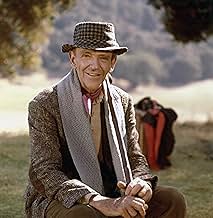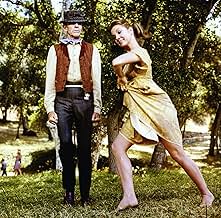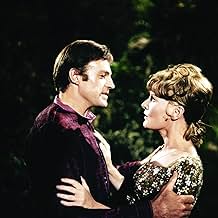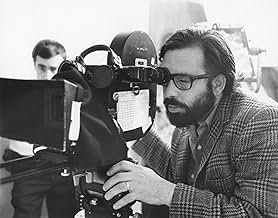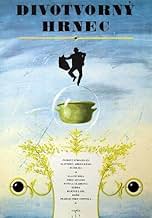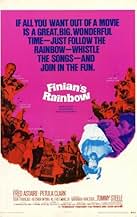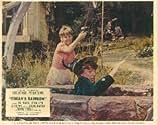IMDb RATING
6.1/10
4.5K
YOUR RATING
An Irish immigrant and his daughter move into a town in the American South with a magical piece of gold that will change people's lives, including a struggling farmer and African American ci... Read allAn Irish immigrant and his daughter move into a town in the American South with a magical piece of gold that will change people's lives, including a struggling farmer and African American citizens threatened by a bigoted politician.An Irish immigrant and his daughter move into a town in the American South with a magical piece of gold that will change people's lives, including a struggling farmer and African American citizens threatened by a bigoted politician.
- Nominated for 2 Oscars
- 1 win & 9 nominations total
Brenda Arnau
- Sharecropper 'Necessity'
- (uncredited)
Charles Carter
- Sharecropper
- (uncredited)
Sterling Clark
- Sharecropper
- (uncredited)
Robert Cleaves
- Geologist
- (uncredited)
Robert Cole
- Sharecropper
- (uncredited)
Willie Covan
- Sharecropper
- (uncredited)
Evelyn Dutton
- Sharecropper
- (uncredited)
Featured reviews
I first saw this movie as a young girl and developed an instant crush on Tommy Steele. The storyline is very entertaining with a keen sense of humor. It was also great seeing Fred Astaire again - I'm a big fan. This movie has some of the most memorable songs which are still among my favorites, of course many of them featuring Petula Clarke. If you are a fan of musicals and enjoy a bit of the blarney - then this movie will be right up your ally.
First, FINIAN'S RAINBOW does not take place in Tennessee. The movie only mentions Rainbow Valley, but onstage the valley is in Missitucky, home to Fort Knox and the gold depository that was thankfully saved by James Bond in later (for the movie, earlier) years.
The movie's flaws lie not so much in the updating to 1968 as in the eyes of today's viewers. We have sadly grown used to movies that are paced much faster than this one. As a result, those too young to have grown up with older movies will consider FINIAN'S RAINBOW very slow and overlong.
Fundamentally, though, FINIAN'S RAINBOW suffers the same afflictions all stage musicals suffer when transcribed to the big screen: Loss of intimacy. Hollywood always makes stage musicals 'way too big. They think musicals have to take place all over the continent. Oddly, a single stage worked for the play, and still does. (Possibly the rare exception to this is THE MUSIC MAN which was "opened up" only enough, not too much.) All movies are of their times, especially movie musicals. Accept that and enjoy FINIAN'S RAINBOW's wonderful score and excellent performances by the entire cast.
The movie's flaws lie not so much in the updating to 1968 as in the eyes of today's viewers. We have sadly grown used to movies that are paced much faster than this one. As a result, those too young to have grown up with older movies will consider FINIAN'S RAINBOW very slow and overlong.
Fundamentally, though, FINIAN'S RAINBOW suffers the same afflictions all stage musicals suffer when transcribed to the big screen: Loss of intimacy. Hollywood always makes stage musicals 'way too big. They think musicals have to take place all over the continent. Oddly, a single stage worked for the play, and still does. (Possibly the rare exception to this is THE MUSIC MAN which was "opened up" only enough, not too much.) All movies are of their times, especially movie musicals. Accept that and enjoy FINIAN'S RAINBOW's wonderful score and excellent performances by the entire cast.
The film version of "Finian's Rainbow" was conceived at a time when the public's interest in movie musicals was on the wane; in fact, in light of the poor critical reception accorded "Camelot" the year before, studio head Jack Warner would have been content to pull the plug on what he perceived as another sure-fire disaster. To an extent, his feelings were justified - what had been a daringly provocative look at racial strife in the deep American South as seen through the eyes of a scheming Irishman and his less-than-supportive daughter when it debuted on Broadway in 1947 was no longer very pertinent twenty-one years later, and the fairy tale aspects of the plot - which included the hyperactive antics of a leprechaun intent on retrieving his "borrowed" pot of gold - were going to be a hard sell in 1968. The score, although exquisitely timeless and highly recognizable, was old-fashioned in its theatricality and not likely to result in a best-selling cast album. Furthermore, directing the project was a virtual unknown, a "hippie" from northern California named Francis Ford Coppola, with only one prior film - a non-musical - to his credit. Given the odds the movie was doomed, Warner basically maintained a "hands-off, don't-ask, don't-tell" policy and simply hoped for the best.
The end result may not have been the "best", but it is considerably better than most critics described it upon its release. The overlong book, with several insignificant sub-plots, could have used some judicious trimming. Tommy Steele's performance as Og, the slowly-turning-into-a-human leprechaun, is frantically overblown. The film's editing is criminal in that Fred Astaire's feet are often unseen in his dance routines. And the attempt to blend reality and make-believe results in an awkwardly uneven balance of the two - Coppola would have been far more successful had he decided to emphasize the whimsical and play down the outdated political aspects of the story. But for all these shortcomings, "Finian's Rainbow" - from its spectacular opening credits to its nicely staged farewell to Finian - almost a goodbye to Astaire himself, for whom this would be his last dancing role - is pleasant entertainment, buoyed by its familiar score and anchored by the presence of Petula Clark, whose delightfully fresh and sweetly seductive performance is the true gold to be discovered here. At the time known in the States as the pop singer responsible for the mega-hit "Downtown", Clark drew on her previous experience as an actress in mostly grade-B British films and developed a character whose acceptance of a leprechaun hiding in the backyard well is as easily believed as her skepticism regarding her father's plot to multiply his borrowed gold by burying it in the shadows of Fort Knox and her fiancé's plans to grow mentholated tobacco. The Arlen/Harburg score - including such standards as "How Are Things in Glocca Morra?" and "Look to the Rainbow" - could well have been composed specifically for her voice, which wraps itself around each note with a hint of a brogue and - in the case of "Old Devil Moon" - a raw sensuality suggesting the woman inside the sweet Irish colleen. Deservedly, Clark was nominated for a Best Actress Golden Globe for her portrayal of Sharon McLonergan, and if for nothing else, her performance makes "Finian's Rainbow" definitely worth a look-see.
The end result may not have been the "best", but it is considerably better than most critics described it upon its release. The overlong book, with several insignificant sub-plots, could have used some judicious trimming. Tommy Steele's performance as Og, the slowly-turning-into-a-human leprechaun, is frantically overblown. The film's editing is criminal in that Fred Astaire's feet are often unseen in his dance routines. And the attempt to blend reality and make-believe results in an awkwardly uneven balance of the two - Coppola would have been far more successful had he decided to emphasize the whimsical and play down the outdated political aspects of the story. But for all these shortcomings, "Finian's Rainbow" - from its spectacular opening credits to its nicely staged farewell to Finian - almost a goodbye to Astaire himself, for whom this would be his last dancing role - is pleasant entertainment, buoyed by its familiar score and anchored by the presence of Petula Clark, whose delightfully fresh and sweetly seductive performance is the true gold to be discovered here. At the time known in the States as the pop singer responsible for the mega-hit "Downtown", Clark drew on her previous experience as an actress in mostly grade-B British films and developed a character whose acceptance of a leprechaun hiding in the backyard well is as easily believed as her skepticism regarding her father's plot to multiply his borrowed gold by burying it in the shadows of Fort Knox and her fiancé's plans to grow mentholated tobacco. The Arlen/Harburg score - including such standards as "How Are Things in Glocca Morra?" and "Look to the Rainbow" - could well have been composed specifically for her voice, which wraps itself around each note with a hint of a brogue and - in the case of "Old Devil Moon" - a raw sensuality suggesting the woman inside the sweet Irish colleen. Deservedly, Clark was nominated for a Best Actress Golden Globe for her portrayal of Sharon McLonergan, and if for nothing else, her performance makes "Finian's Rainbow" definitely worth a look-see.
"Finian's Rainbow" (1968) is one of the few films I saw three times in the theater, and since repeat viewings are normally not my thing it must have made some connection or maybe I just enjoyed watching Barbara Hancock dance. Despite this I agree with most of the critical comments about portions of the film.
Unfortunately it was assembled as a 145 minute "roadshow" musical; these were overlong spectaculars which depended less on the charm of the performers (think 1930's) than on pre-sold event marketing (unnecessary, pretentious, overscale, and distracting production values; souvenir programs; etc.). Right around the time of its release these mega-productions were leading many of the studios to financial ruin. Warner Brothers took a hit from this one; box office was bad but fortunately Coppola worked cheap and had cranked this out on the back-lot with a relatively modest budget.
Trim about 30 minutes from the film and you would have a much better production. There is a lot of stuff here that is supposed to be fun and just doesn't make it. Fortunately there are some real gems sandwiched throughout the film.
Think bi-racial "Lil Abner" (1959) with a touch of "The Wizard of Oz" (1939). The Oz connection comes from lyricist E. Y. Harburg, the guy who gave us "If I Were the King of the Forest". There are enough such silly songs to make up for toughing out the musical clunker moments. Tommy Steele absolutely shines doing this material (insert Bert Lahr here) .
Nothing wrong with the performances of Fred Astaire or Petula Clark either. And its not just his dancing and her singing, they both achieve excellent characterizations. Astaire at 70 does not look much different facially than Astaire at 30. But this time instead of a physically unlikely love interest he plays a warm old man still chasing a dream, and it's a much better fit. Clark does an excellent Debbie Reynolds and more than holds her own through the production.
Unfortunately there is little good to say about the casting of Don Francks as Petula's love interest and Hancock's older brother. Most likely Coppola felt that the film needed a relatively hip looking guy in place of a Gordon MacRae type. But Francks comes off as more of an oily hotshot; the kind of guy who would proposition your 14 year-old sister.
The plot has Finian and his daughter coming to Kentucky to bury a crock of gold he has stolen from a leprechaun back in Ireland. Finian believes that he can produce some kind of synergy by getting the gold within close range of Ft. Knox. They end up in a racially mixed Dogpatch named Rainbow Valley, where blacks and whites work side-by-side as tobacco sharecroppers. There is considerable intrigue involving the local racist political hacks, a new strain of mentholated tobacco being developed by a George Washington Carver type (nicely played by Al Freeman Jr.), back taxes on the sharecropping collective, romance, and a leprechaun who is slowly becoming human.
Barbara Hancock, a young but quite accomplished ballet dancer, is fetching as "Susan the Silent" (who dances instead of talking). Coppola adds a lot of nice lyrical moments by showcasing her dancing. It is said that Astaire resented her being cast instead of an older dancer he recommended. They are not paired in any number, a failure conspicuous by its absence.
The widescreen DVD looks great and the Coppola commentary is surprisingly interesting.
Then again, what do I know? I'm only a child.
Unfortunately it was assembled as a 145 minute "roadshow" musical; these were overlong spectaculars which depended less on the charm of the performers (think 1930's) than on pre-sold event marketing (unnecessary, pretentious, overscale, and distracting production values; souvenir programs; etc.). Right around the time of its release these mega-productions were leading many of the studios to financial ruin. Warner Brothers took a hit from this one; box office was bad but fortunately Coppola worked cheap and had cranked this out on the back-lot with a relatively modest budget.
Trim about 30 minutes from the film and you would have a much better production. There is a lot of stuff here that is supposed to be fun and just doesn't make it. Fortunately there are some real gems sandwiched throughout the film.
Think bi-racial "Lil Abner" (1959) with a touch of "The Wizard of Oz" (1939). The Oz connection comes from lyricist E. Y. Harburg, the guy who gave us "If I Were the King of the Forest". There are enough such silly songs to make up for toughing out the musical clunker moments. Tommy Steele absolutely shines doing this material (insert Bert Lahr here) .
Nothing wrong with the performances of Fred Astaire or Petula Clark either. And its not just his dancing and her singing, they both achieve excellent characterizations. Astaire at 70 does not look much different facially than Astaire at 30. But this time instead of a physically unlikely love interest he plays a warm old man still chasing a dream, and it's a much better fit. Clark does an excellent Debbie Reynolds and more than holds her own through the production.
Unfortunately there is little good to say about the casting of Don Francks as Petula's love interest and Hancock's older brother. Most likely Coppola felt that the film needed a relatively hip looking guy in place of a Gordon MacRae type. But Francks comes off as more of an oily hotshot; the kind of guy who would proposition your 14 year-old sister.
The plot has Finian and his daughter coming to Kentucky to bury a crock of gold he has stolen from a leprechaun back in Ireland. Finian believes that he can produce some kind of synergy by getting the gold within close range of Ft. Knox. They end up in a racially mixed Dogpatch named Rainbow Valley, where blacks and whites work side-by-side as tobacco sharecroppers. There is considerable intrigue involving the local racist political hacks, a new strain of mentholated tobacco being developed by a George Washington Carver type (nicely played by Al Freeman Jr.), back taxes on the sharecropping collective, romance, and a leprechaun who is slowly becoming human.
Barbara Hancock, a young but quite accomplished ballet dancer, is fetching as "Susan the Silent" (who dances instead of talking). Coppola adds a lot of nice lyrical moments by showcasing her dancing. It is said that Astaire resented her being cast instead of an older dancer he recommended. They are not paired in any number, a failure conspicuous by its absence.
The widescreen DVD looks great and the Coppola commentary is surprisingly interesting.
Then again, what do I know? I'm only a child.
Opening on Broadway in 1947 with music by Burton Lane and lyrics by E.Y. "Yip" Harburg (who wrote the lyrics for 1939's THE WIZARD OF OZ), FINIAN'S RAINBOW was an unexpected smash that generated one pop classic after another--"How Are Things In Glocca Morra?," "Old Devil Moon," and "Look To The Rainbow" to name but three. But when talk turned to a film version, not a single studio in Hollywood would touch it: although the story was fantasy, it was also extremely satirical, contained elements that had a decidedly socialist edge, and made one of the most wickedly funny statements on racism seen up to that time. With Hollywood operating under the production code and the nation drifting into the communist paranoia of the 1950s, the whole thing was impossibly hot. And so FINIAN'S RAINBOW remained off the screen for over twenty years... until 1968, when a sudden splash of popular screen musicals prompted Warner Brothers to bankroll it.
The plot is deliberately ridiculous, and finds Irishman Finian McLonergan (Fred Astaire) and his long suffering daughter Sharon (Petula Clark) in Tennessee, where Finian plans to bury a crock of gold stolen from a leprechaun (Tommy Steele) on the theory that the land around Fort Knox will make the gold grow. But things take an unexpected turn when they arrive in Rainbow Valley, where they encounter a commune of black and white tobacco sharecroppers doing battle with a viciously bigoted Senator (Keenan Wynn.) And when daughter Sharon is outraged by the Senator's racism and happens to be standing by the hidden crock of gold--she accidentally "wishes" the Senator black! Unlike the 1947 stage show, the big screen version of FINIAN'S RAINBOW tanked at the box office, and it is little wonder: both producers and then-novice director Francis Ford Coppola made a host of very basic mistakes with the material, the first of which was not keeping the film within its original 1940s context; they instead give it a 'contemporary' tone that not only undercuts the fanciful storyline but makes many of the story's elements seem heavy-handed. In the process they manage to blunt the edge of the original in a very significant sort of way. There are also a number of cinematic problems with the movie, which feels awkwardly filmed and still more awkwardly edited, and the film visibly shifts between outdoor set-ups and studio soundstage sets in a very uncomfortable sort of way.
All of that said, there is still a great deal to enjoy in FINIAN'S RAINBOW--the aforementioned score for one and the truly memorable performances for another. Astaire is timeless, Tommy Steele almost walks away with the show, Keegan Wynn (in spite of some rather ill-advised make-up) gives a memorable performance as the bigoted Senator, and Al Freeman Jr. is absolutely hilarious in the sequence where he applies for the job of butler in the Senator's home--I laugh just thinking about it! But the real revelation here is Petula Clark. Best known as a pop singer, Clark is perfection as Sharon McLonergan; it is a tremendous pity that she was never again so well-cast on screen. And together they manage to gloss over most of the film's weaknesses; if you're a musical fan, you're likely to enjoy it.
Gary F. Taylor, aka GFT, Amazon Reviewer
The plot is deliberately ridiculous, and finds Irishman Finian McLonergan (Fred Astaire) and his long suffering daughter Sharon (Petula Clark) in Tennessee, where Finian plans to bury a crock of gold stolen from a leprechaun (Tommy Steele) on the theory that the land around Fort Knox will make the gold grow. But things take an unexpected turn when they arrive in Rainbow Valley, where they encounter a commune of black and white tobacco sharecroppers doing battle with a viciously bigoted Senator (Keenan Wynn.) And when daughter Sharon is outraged by the Senator's racism and happens to be standing by the hidden crock of gold--she accidentally "wishes" the Senator black! Unlike the 1947 stage show, the big screen version of FINIAN'S RAINBOW tanked at the box office, and it is little wonder: both producers and then-novice director Francis Ford Coppola made a host of very basic mistakes with the material, the first of which was not keeping the film within its original 1940s context; they instead give it a 'contemporary' tone that not only undercuts the fanciful storyline but makes many of the story's elements seem heavy-handed. In the process they manage to blunt the edge of the original in a very significant sort of way. There are also a number of cinematic problems with the movie, which feels awkwardly filmed and still more awkwardly edited, and the film visibly shifts between outdoor set-ups and studio soundstage sets in a very uncomfortable sort of way.
All of that said, there is still a great deal to enjoy in FINIAN'S RAINBOW--the aforementioned score for one and the truly memorable performances for another. Astaire is timeless, Tommy Steele almost walks away with the show, Keegan Wynn (in spite of some rather ill-advised make-up) gives a memorable performance as the bigoted Senator, and Al Freeman Jr. is absolutely hilarious in the sequence where he applies for the job of butler in the Senator's home--I laugh just thinking about it! But the real revelation here is Petula Clark. Best known as a pop singer, Clark is perfection as Sharon McLonergan; it is a tremendous pity that she was never again so well-cast on screen. And together they manage to gloss over most of the film's weaknesses; if you're a musical fan, you're likely to enjoy it.
Gary F. Taylor, aka GFT, Amazon Reviewer
Did you know
- TriviaMany, including Fred Astaire, blamed director Francis Ford Coppola for cutting off Astaire's feet during filming of his dancing scenes, but it was Warner Bros. who decided, after the filming had been completed in 35mm, to convert the film to the wider 70mm and promote it as a "reserved-ticket roadshow attraction." This was achieved by cropping off the tops and bottoms of the film frame, including some shots of Astaire's footwork.
- GoofsIn the song "Old Devil Moon" as Woody and Sharon dance through the stream, Woody has bare feet and his hands are in Sharon's. In the next shot, he has his shoes on, and it even looks as if his trousers are dry.
- Alternate versionsFilmed in 35mm, Warners decided afterwards to promote it as a "reserved-ticket roadshow attraction" and converted it to 70mm, creating a wider-screen aspect ratio by cropping away the tops and bottoms of the images, and cropping away Fred Astaire's feet during some of his dance scenes. Restored versions show the original aspect ratio.
- ConnectionsEdited into The Kid Stays in the Picture (2002)
- SoundtracksLook To The Rainbow / How Are Things In Glocca Morra?
(1946) (uncredited)
(Main Title)
Played during the opening credits
Lyrics by E.Y. Harburg
Music by Burton Lane
Sung by Petula Clark ("Rainbow") and played by the Warner Bros.
Orchestra ("Glocca Morra") conducted by Ray Heindorf
- How long is Finian's Rainbow?Powered by Alexa
Details
Box office
- Budget
- $3,500,000 (estimated)
- Runtime2 hours 21 minutes
- Aspect ratio
- 2.39 : 1
Contribute to this page
Suggest an edit or add missing content


